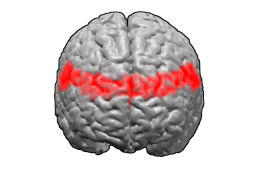Human[]
Brodmann area 9, or BA9, is part of the frontal cortex in the human brain.
Guenon[]
The term Brodmann area 9 refers to a cytoarchitecturally defined portion of the frontal lobe of the guenon. Brodmann-1909 regarded it on the whole as topographically and cytoarchitecturally homologous to the granular frontal area 9 and frontopolar area 10 in the human. Distinctive features (Brodmann-1905): unlike Brodmann area 6-1909, area 9 has a distinct internal granular layer (IV); unlike Brodmann area 6 or Brodmann area 8-1909 its internal pyramdal layer (V) is divisible into two sublayers, an outer layer 5a of densely distributed medium sized ganglion cells that partially merges with layer IV, and an inner, clearer, cell-poor layer 5b; the pyramidal cells of sublayer 3b of the external pyramidal layer (III) are smaller and sparser in distribution; the external granular layer (II) is narrow, with small numbers of sparsely distributed granule cells.
External links[]
- For Neuroanatomy of this area see BrainInfo
See also[]
Assessment |
Biopsychology |
Comparative |
Cognitive |
Developmental |
Language |
Individual differences |
Personality |
Philosophy |
Social |
Methods |
Statistics |
Clinical |
Educational |
Industrial |
Professional items |
World psychology |
Biological: Behavioural genetics · Evolutionary psychology · Neuroanatomy · Neurochemistry · Neuroendocrinology · Neuroscience · Psychoneuroimmunology · Physiological Psychology · Psychopharmacology (Index, Outline)
| This page uses Creative Commons Licensed content from Wikipedia (view authors). |
